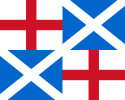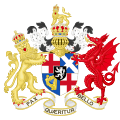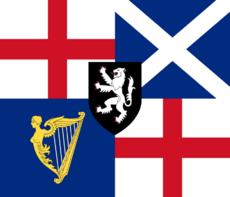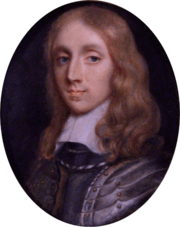The Protectorate facts for kids
Quick facts for kids
Commonwealth of England, Scotland and Ireland
|
|||||||||||
|---|---|---|---|---|---|---|---|---|---|---|---|
| 1653–1659 | |||||||||||
|
Motto: Pax quaeritur bello
("Peace is obtained through war") |
|||||||||||

The territory of the Commonwealth in 1659
|
|||||||||||
| Capital | London | ||||||||||
| Common languages | English (official) Scots, Irish, Welsh, Cornish, Scottish Gaelic, Norn, Yola, Fingallian |
||||||||||
| Religion | Protestantism | ||||||||||
| Government | Unitary parliamentary republic with an executive presidency under a hereditary military dictatorship | ||||||||||
| Lord Protector | |||||||||||
|
• 1653–1658
|
Oliver Cromwell | ||||||||||
|
• 1658–1659
|
Richard Cromwell | ||||||||||
| Legislature | Parliament | ||||||||||
| Other House (1658–59) |
|||||||||||
| House of Commons (1654–55/1656–58/1659) |
|||||||||||
| History | |||||||||||
| 16 December 1653 | |||||||||||
| 12 April 1654 | |||||||||||
| 25 May 1657 | |||||||||||
|
• R. Cromwell's resignation
|
25 May 1659 | ||||||||||
| Currency | Pound sterling (England) Pound Scots (Scotland) Irish pound (Ireland) |
||||||||||
|
|||||||||||
| Today part of | Republic of Ireland United Kingdom |
||||||||||
The Protectorate, officially known as the Commonwealth of England, Scotland and Ireland, was a special type of government in England. It lasted from December 16, 1653, to May 25, 1659. During this time, the kingdoms of England, Scotland, and Ireland were united. They were all governed by a leader called the Lord Protector.
This period began when a group called Barebone's Parliament was dissolved. A new document, the Instrument of Government, then named Oliver Cromwell as the first Lord Protector. Cromwell led the country until he died in September 1658. His son, Richard Cromwell, took over after him.
However, Richard Cromwell found it hard to control the army and the Parliament. He resigned in May 1659. After his resignation, the English Committee of Safety took charge. This group brought back the "Rump Parliament," which Oliver Cromwell had dismissed earlier. This change marked the end of the Protectorate.
Contents
How the Protectorate Started
Before the Protectorate, from 1649, England, Ireland, and later Scotland were run as a republic. This meant they had no king or queen. Instead, they were governed by the Council of State and the Rump Parliament. England was officially declared a republic on May 19, 1649. This happened after the execution of Charles I in January of that year. Ireland also came under this government after England took control of it.
On April 20, 1653, Oliver Cromwell became unhappy with the Rump Parliament. He felt they were trying to stay in power too long and couldn't agree on a new constitution. So, Cromwell, with the support of his army, marched soldiers into Parliament. He forced the Rump Parliament to end its session.
Within a month, Cromwell decided to try a new form of government. He asked churches in each county to suggest people for a new assembly. This new group, called the "Nominated Assembly," or Barebone's Parliament, started on July 4. However, this assembly also proved difficult to control. It was also made fun of by the public. So, on December 8, members who supported Cromwell ended the assembly. Soldiers removed those who disagreed.
Because this assembly failed, Cromwell's military leaders created the Instrument of Government. This document set up the Protectorate and gave power to Oliver Cromwell.
Oliver Cromwell's Time as Leader
After Barebone's Parliament ended, John Lambert created the new constitution, the Instrument of Government. This document made Cromwell the Lord Protector for life. His job was to be the main leader and manage the government. He could call and end parliaments. However, he had to get the agreement of the Council of State for most decisions. Cromwell's power was also strong because the army liked him. He had built up this support during the civil wars. Cromwell officially became Lord Protector on December 16, 1653.
Rule of the Major-Generals
The First Protectorate Parliament met on September 3, 1654. It started to work on making changes to the government. But Cromwell dissolved it on January 22, 1655. This happened after a royalist uprising led by Sir John Penruddock.
Cromwell then divided England into military areas. These areas were ruled by Army Major-Generals. These generals answered only to Cromwell. There were fifteen major generals and deputy major generals. They were sometimes called "godly governors." They were important for national safety and for Cromwell's plan to improve public morals. These generals oversaw local soldiers and security groups. They also collected taxes and made sure people supported the government.
However, the major-generals lasted less than a year. Many people worried that they were becoming too powerful. A plan to tax people to pay for the generals' work was rejected by the Second Protectorate Parliament. People feared this tax would lead to a permanent military government. In the end, Cromwell did not fully support his generals, which led to their downfall. Their actions had also made many people dislike the government even more.
Scotland and Ireland
By the end of 1653, the Protectorate was the first government to control all of the British Isles. The Instrument of Government included Scotland and Ireland in its rule. It allowed representatives from Scotland and Ireland to join Parliament in London.
The government's plan for Ireland and Scotland had three main parts. First, they wanted to keep control of these countries with their armies. Second, they wanted to punish those who had fought against England. Third, they aimed to make both countries more like England. Historian Barry Coward noted that the goal was to make the British Isles more "English."
Scotland
After the Scottish army lost the Anglo-Scottish war (1650–1652), the English Parliament took over Scotland. Military rule was put in place. About 10,000 English soldiers were stationed across Scotland to prevent uprisings. Talks began to officially join Scottish laws and politics with the new British state.
Under the Tender of Union, declared in 1652, the Scottish Parliament was permanently dissolved. Scotland was given 30 seats in the Westminster Parliament in London. In 1654, an "Ordinance for uniting Scotland into one Commonwealth with England" was issued. This document made the union legal until it became an official Act of Union in 1657.
At first, eight English officials ran Scotland. In 1655, Lord Broghill became the head of a new Council for Scotland. This council aimed to make the government more civilian and gain support from important Scottish landowners. The council had six Englishmen and two Scots.
Ireland
After the difficult Cromwellian conquest of Ireland in 1653, the Protectorate put in place strict laws. The Act for the Settlement of Ireland 1652 meant that many Irish people lost their lands. Most Catholic landowners had to move to the west of the country. The English army in Ireland was about 9,000 soldiers in 1657.
The Instrument of Government said that Ireland would have 30 seats in the London Parliament, just like Scotland. At first, Cromwell's son-in-law, Charles Fleetwood, governed Ireland. He was a military governor called the Lord Deputy of Ireland. He worked with a group of strict parliamentary officials. In 1655, a more moderate approach was taken. Cromwell sent his son, Henry, to Ireland. Henry took control and tried to be more fair in how the country was run.
Foreign Policy
Oliver Cromwell also dealt with challenges in foreign policy. The First Anglo-Dutch War against the Dutch Republic ended in 1654. Admiral Robert Blake led England to victory. After making peace with the Dutch, Cromwell started a war with the Spanish Empire. This plan, called the Western Design, involved attacking Spanish colonies in the Caribbean. This led to England taking over Jamaica, which became an English colony.
Cromwell also noticed that Jewish communities helped the Netherlands' economy. The Netherlands was England's main trading rival. Cromwell was also tolerant of private worship for non-Puritans. This led him to encourage Jewish people to return to England. They had been banished by Edward I 350 years earlier. Cromwell hoped they would help England's economy recover after the Civil Wars.
In 1655, a Jewish man named Simón de Casseres suggested a plan to Cromwell. He proposed taking over Spanish-ruled Chile with only a few ships and men. However, English plans for Chile didn't happen until 1669.
After the Battle of the Dunes (1658), the town of Dunkirk was given to the Protectorate by France. However, Charles II later sold it back to France in 1662.
Oliver Cromwell's Role as Lord Protector
In 1657, Parliament offered Oliver Cromwell the crown. This was part of a new plan for the government. This was a difficult decision for Cromwell. He had been a key figure in getting rid of the monarchy. Cromwell thought about the offer for six weeks. He liked the idea of stability that a king could bring. But in a speech on April 13, 1657, he said that God had shown that the office of king should not return. He said he would not "build Jericho again."
Instead, Cromwell was officially reinstalled as Lord Protector. He was given more powers than before. The ceremony took place at Westminster Hall. He sat on King Edward's Chair, which was brought from Westminster Abbey. The event was similar to a coronation in some ways. It used symbols like a purple robe, a sword, and a sceptre. He also wore a coronet, but not a crown. However, a crown and an orb were on the Lord Protector's official seal.
The office of Lord Protector was still not hereditary. But Cromwell could now choose his own successor. Cromwell's new rights and powers were written in the Humble Petition and Advice. This document replaced the Instrument of Government. Cromwell himself tried to make his role seem less grand. He described himself as a "constable" or "watchman." However, Cromwell never fully gained the support of the nation. The Protectorate relied on the army to stay in power.
Richard Cromwell's Time as Leader
After Oliver Cromwell died in September 1658, his third son, Richard Cromwell, became the next Lord Protector. At first, the Protectorate seemed strong. But this impression was misleading. The lack of unity soon caused the Protectorate to fall apart.
Richard wanted to gain more support for the Protectorate beyond just the army. He called a Parliament in 1659. But members who wanted a republic caused many problems. They criticized the Protectorate for being too much like a monarchy. They also said that Oliver's rule had been a time of harsh government and economic problems. Both Oliver and Richard were seen as leading a government controlled by the "Sword" (the army). This was the opposite of a "Civil" government with a free Parliament.
Three main things weakened the Protectorate: the army's worries, Parliament's lack of responsibility, and Richard Cromwell's hasty decisions. What finally ended the Protectorate was the opposition from junior officers and many ordinary soldiers.
Richard showed that he could not manage Parliament or control the army. On May 7, a Committee of Safety was formed. This group took over from the Protector's Council of State. It was then replaced by a new Council of State on May 19, 1659. Richard was never officially removed or arrested. He was simply allowed to fade away. The Protectorate was then seen as a government that had taken power illegally from the start.
What Happened Next: The Monarchy Returns
After Richard Cromwell lost power, the Rump Parliament was brought back. Soon after, it was replaced by the Committee of Safety and the Council of State. These groups were under the authority of Charles Fleetwood. The Committee of Safety ordered General John Lambert to confront George Monck. Monck was the commander of English forces in Scotland and supported the return of the king. Lambert was told to make Monck surrender or defeat him.
However, Monck marched south instead. As Lambert's army marched north, his soldiers began to leave. He was eventually forced to retreat back to London.
When Monck reached London, he allowed Presbyterian members to return to Parliament on February 21, 1660. These members had been removed earlier. On March 16, 1660, the Long Parliament dissolved itself. This cleared the way for the Convention Parliament of 1660. On April 4, 1660, Charles II issued the Declaration of Breda. This promised forgiveness for all crimes during the Civil War to those who recognized him as the rightful king. On May 8, 1660, the Convention Parliament declared Charles II the lawful king. The Convention Parliament then began the process of bringing the monarchy back. This was known as the Restoration Settlement.
Historian Derek Hirst notes that outside of politics and religion, the 1640s and 1650s saw a growing economy. There was more manufacturing, new ways of handling money, and better communication. People had more time for fun activities like horse racing. In culture, there was a growing market for music. Scientific research increased, and more books were published. All these new trends were discussed in the newly opened coffeehouses.
See also
 In Spanish: El Protectorado para niños
In Spanish: El Protectorado para niños







